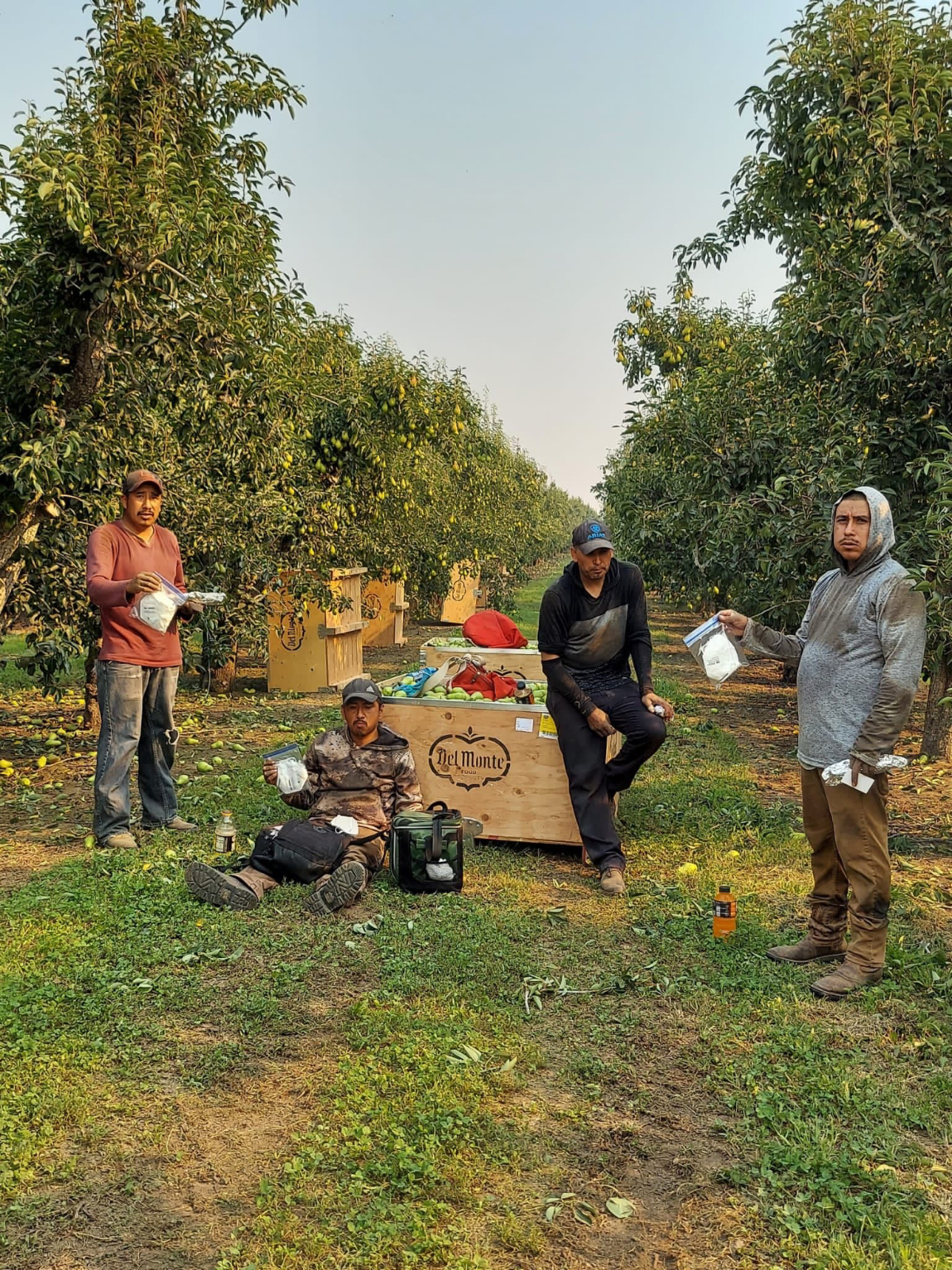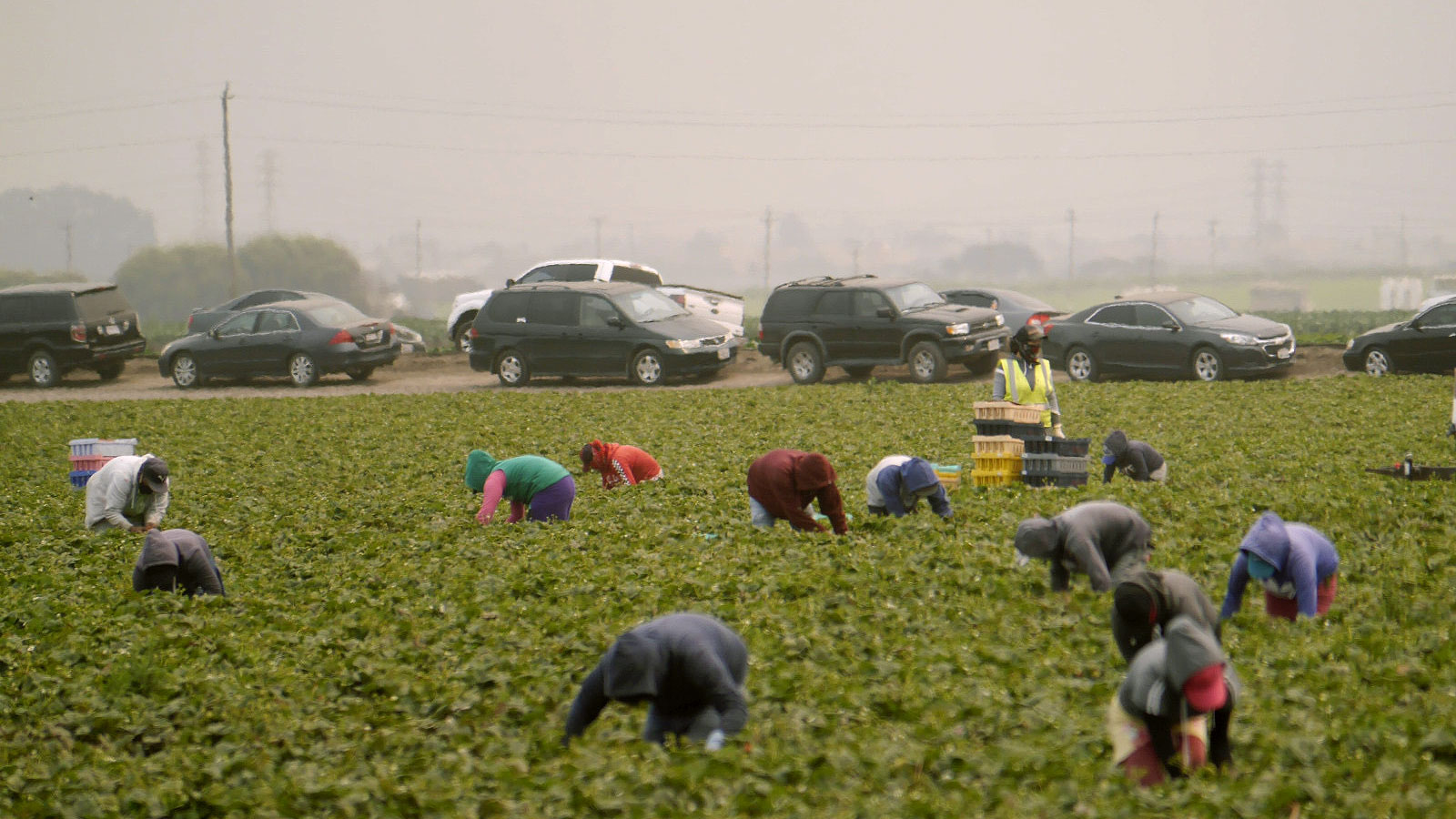Last summer, the Pacific Northwest was hit by a once-in-a-millenium heat dome. While temperatures were higher than ever recorded, L.A.* was outside, working Washington’s blueberry harvest. (Fearing potential work repercussions, L.A. did not wish to be identified by her full name.) Soon, she was dehydrated, dizzy, and vomiting. Her minor son, who was also working in the field out in the heat, got a bloody nose and headache. When the harvest was moved to the middle of the night to avoid the most intense heat—”to protect the fruit, not the workers,” L.A. says—her friend cut herself badly laboring in the dark.
Whether it’s heatwaves, wildfire smoke, or attempts to adapt that create new hazards, the climate crisis is exacerbating risks for America’s workers. From home health aides and school teachers to construction and farm workers, people across the country are now facing compounding challenges on the widening frontlines of the climate crisis. Yet federal protections for the workplace have not kept pace.
During California’s recent wildfires, shocking photos emerged of farmworkers harvesting grapes in California vineyards under an orange-tinged sky. That may be one of the most visible examples of people being forced to work in dangerous conditions, but it’s far from the only climate-related health risk employees regularly face. “The reality is that millions of workers—across our society—are being exposed to multiple environmental stressors all at once, including searing heat and toxic air pollution,” says Dr. Vijay Limaye, senior scientist at the Natural Resources Defense Council (NRDC).
For instance, Limaye explains that the formation of ground level ozone—air pollution formed in the atmosphere from building blocks including emissions from burning coal, oil, and gas—is intensified by hotter temperatures. The Environmental Protection Agency (EPA) is responsible for setting exposure limits, but the agency’s models often don’t account for compounding circumstances or cumulative impacts. While the EPA sets some legal limits for ozone, for example, outdoor workers are frequently exposed to smog and extreme temperatures simultaneously. From a health risk perspective, “the sum is often greater than the parts,” Limaye says.

The cumulative impact, however, is significant and inequitable: According to the American Lung Association’s 2022 “State of the Air” report, four in 10 Americans live with unhealthy levels of soot or ozone air pollution, with heightened burdens on communities of color. Limaye previously worked as a scientist for the EPA, where he focused on Clean Air Act implementation, and he says there is broad consensus in the epidemiological community that there is no safe level of exposure to any kind of air pollution. “The agency needs to bring its air pollution and health analyses up to date with where the science is at,” Limaye says. While using demographic data from specific zip codes, rather than coarser county level averages could help the EPA develop more protective air pollution limits, the big-picture reality is that “climate change is going to exacerbate every health issue and make people sicker,” Limaye says.
Living in consistently unhealthy conditions—with chronic stress from things like ozone pollution compounding over time—makes it that much harder to cope with increasingly drastic climate events. While the National Oceanic and Atmospheric Agency keeps a tally of natural disasters that cause over a billion dollars in damage to property and infrastructure, the agency doesn’t count the toll on human health. Nevertheless, the glut of climate events are also public health crises, Limaye says. “It’s about shortened and sicker lives, burdened families, threats to mental health—there’s all sorts of costs and consequences that just really aren’t registering.” The recent Supreme Court ruling in West Virginia v. EPA is also going to make regulating greenhouse gas emissions even more difficult.
Seeing the extent of these health inequities in Louisiana communities following Hurricane Katrina was so jarring that former wildlife biologist Juanita Constible changed her career, shifting her focus to human health. Now a senior advocate for climate and health at NRDC, she’s developing and advocating for health protections for workers, and community-level climate solutions.
With extreme heat waves increasing in frequency and duration, Constible says that action is needed. “I think there’s a real blind spot when it comes to how we talk about climate solutions,” she says. “Cutting emissions is absolutely essential. But that’s not going to help the people whose homes are underwater, or who have to work in 105 degrees right now.”
This June, 60 million people across the United States were under excessive heat warnings or heat advisories, with the National Weather Service issuing nearly three times as many advisories as last year at this time. “There are millions of workers all across the country that are under-protected from heat right now. And the existing tools that the Occupational Safety and Health Administration (OSHA) has are hypothetically supposed to cover heat, but they’re not built for the task,” Constible says. The current rules and protections are just too difficult to enforce, she says, and are often unevenly applied to temporary workers or workers deemed essential to the economy—and not at all to domestic workers.
In October of 2021, federal agencies outlined climate action plans for the first time since the Obama presidency, but Constible says “they still really lacked the urgency to take a hard look at existing policies and programs,” stressing that rapidly changing conditions have to be factored into federal workplace policies. Nor can policymakers rely on historical conditions as an indicator of future risks—as temperatures spike in formerly temperate regions, for example, school buildings need to be retrofitted so children can safely learn. “I’m deeply interested in making sure that people survive and thrive now,” she says.
Echoing other health disparities in the United States, exposure to heat stress, air pollution, flooding, and toxic chemicals falls disproportionately on historically redlined communities. “There’s a divide between people who have escaped harm, and those who have had repeated harm,” Constible says. “Heat at its most essential level is about housing,” she adds; not having a cool place to recover at night intensifies workers’ heat stress.
While tackling the climate crisis at a federal level has proven politically divisive, in some cases targeted local interventions could go a long way. Constible suggests even things like providing shelter at bus stops in redlined neighborhoods, which are far more likely to be exposed to the elements, would help offer essential workers protection from extreme heat.
Taking steps towards these kinds of solutions is more urgent now than ever. “We know what it takes to keep people from dying of heat,” says Elizabeth Strater, an organizer with United Farm Workers. By and large, those things are very simple: information about critical symptoms, access to shade, paid rest breaks, and sufficient fluids. But only a handful of states have policies about working in extreme heat, and regulators have been slow to develop federal standards. In their absence, people are forced to choose between their employment and taking care of their health and their families, putting them in an impossible situation.
Strater explains that farmworkers are increasingly aware that heat can be life-threatening. “They’re thinking about how to stay alive today, constantly,” she says. But while you can feel heat, the insidious harms of chronic smoke and air pollution are harder to address. In California, even during mandatory fire evacuations, agricultural employers are allowed to bring farmworkers in to continue harvesting. “These workers are being brought in to preserve capital, at risk of their lives,” Strater says. They may not see the health impacts of chronic exposure to dirty air from one day to the next, but the impact accumulates over time, she says. “Your whole life, you’re making really significant sacrifices.”
Sometimes, it’s not a choice. Migrant workers are often dependent on their employer for housing, food, and transportation. Some workers are threatened with deportation, or face other challenges in requesting the protections that do exist under federal labor laws.
“I wish [farm owners] would think a little bit about us,” L.A. says, “that they would give us shade, personal protection equipment, plenty of water, clean bathrooms. They don’t truly think about us.” When harvests were shifted to overnight during last year’s heat dome, for example, parents had to scramble to find childcare or risk losing their jobs.
There are many loopholes in current OSHA policies, like temporary workers not being classified as employees. But Strater says that while federal agencies strive to improve federal heat standards, enforceable emergency rules are immediately needed to protect workers. “Nobody’s held accountable,” she says, “and yet farmworkers do die every year from heat. Every single one of those deaths is preventable.”
Since 1970, NRDC has been guided by the fundamental belief that environmental rights are human rights. Today, supported by more than 3 million members and online activists, we are leading the fight against climate change. Our scientists, lawyers, and policy experts work in partnership with artists, entertainers, and influencers to create a compelling vision for the future: clean air, safe water, and justice for all people. Because, together, science and storytelling will change the world.



